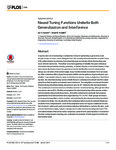Neural Tuning Functions Underlie Both Generalization and Interference
| dc.contributor.author | Howard, IS | |
| dc.contributor.author | Franklin, DW | |
| dc.date.accessioned | 2015-07-18T23:09:04Z | |
| dc.date.available | 2015-07-18T23:09:04Z | |
| dc.date.issued | 2015 | |
| dc.identifier.issn | 1932-6203 | |
| dc.identifier.issn | 1932-6203 | |
| dc.identifier.other | ARTN e0131268 | |
| dc.identifier.uri | http://hdl.handle.net/10026.1/3443 | |
| dc.description.abstract |
In sports, the role of backswing is considered critical for generating a good shot, even though it plays no direct role in hitting the ball. We recently demonstrated the scientific basis of this phenomenon by showing that immediate past movement affects the learning and recall of motor memories. This effect occurred regardless of whether the past contextual movement was performed actively, passively, or shown visually. In force field studies, it has been shown that motor memories generalize locally and that the level of compensation decays as a function of movement angle away from the trained movement. Here we examine if the contextual effect of past movement exhibits similar patterns of generalization and whether it can explain behavior seen in interference studies. Using a single force-field learning task, the directional tuning curves of both the prior contextual movement and the subsequent force field adaptive movements were measured. The adaptation movement direction showed strong directional tuning, decaying to zero by 90° relative to the training direction. The contextual movement direction exhibited a similar directional tuning, although the effect was always above 60%. We then investigated the directional tuning of the passive contextual movement using interference tasks, where the contextual movements that uniquely specified the force field direction were separated by ±15° or ±45°. Both groups showed a pronounced tuning effect, which could be well explained by the directional tuning functions for single force fields. Our results show that contextual effect of past movement influences predictive force compensation, even when adaptation does not require contextual information. However, when such past movement contextual information is crucial to the task, such as in an interference study, it plays a strong role in motor memory learning and recall. This work demonstrates that similar tuning responses underlie both generalization of movement direction during dynamic learning and contextual movements in both single force field and interference tasks. | |
| dc.format.extent | e0131268-e0131268 | |
| dc.format.medium | Electronic-eCollection | |
| dc.language | en | |
| dc.language.iso | eng | |
| dc.publisher | Public Library of Science (PLoS) | |
| dc.subject | Adaptation, Physiological | |
| dc.subject | Adolescent | |
| dc.subject | Athletic Performance | |
| dc.subject | Biomechanical Phenomena | |
| dc.subject | Female | |
| dc.subject | Humans | |
| dc.subject | Learning | |
| dc.subject | Male | |
| dc.subject | Mental Recall | |
| dc.subject | Models, Neurological | |
| dc.subject | Models, Psychological | |
| dc.subject | Motor Skills | |
| dc.subject | Movement | |
| dc.subject | Normal Distribution | |
| dc.subject | Psychomotor Performance | |
| dc.subject | Robotics | |
| dc.subject | User-Computer Interface | |
| dc.subject | Young Adult | |
| dc.title | Neural Tuning Functions Underlie Both Generalization and Interference | |
| dc.type | journal-article | |
| dc.type | Article | |
| plymouth.author-url | https://www.ncbi.nlm.nih.gov/pubmed/26110871 | |
| plymouth.issue | 6 | |
| plymouth.volume | 10 | |
| plymouth.publication-status | Published online | |
| plymouth.journal | PLOS ONE | |
| dc.identifier.doi | 10.1371/journal.pone.0131268 | |
| plymouth.organisational-group | /Plymouth | |
| plymouth.organisational-group | /Plymouth/Faculty of Science and Engineering | |
| plymouth.organisational-group | /Plymouth/Faculty of Science and Engineering/School of Engineering, Computing and Mathematics | |
| plymouth.organisational-group | /Plymouth/REF 2021 Researchers by UoA | |
| plymouth.organisational-group | /Plymouth/REF 2021 Researchers by UoA/UoA11 Computer Science and Informatics | |
| plymouth.organisational-group | /Plymouth/Users by role | |
| plymouth.organisational-group | /Plymouth/Users by role/Academics | |
| dc.publisher.place | United States | |
| dcterms.dateAccepted | 2015-06-01 | |
| dc.identifier.eissn | 1932-6203 | |
| dc.rights.embargoperiod | No embargo | |
| rioxxterms.versionofrecord | 10.1371/journal.pone.0131268 | |
| rioxxterms.licenseref.uri | http://www.rioxx.net/licenses/all-rights-reserved | |
| rioxxterms.licenseref.startdate | 2015 | |
| rioxxterms.type | Journal Article/Review |


